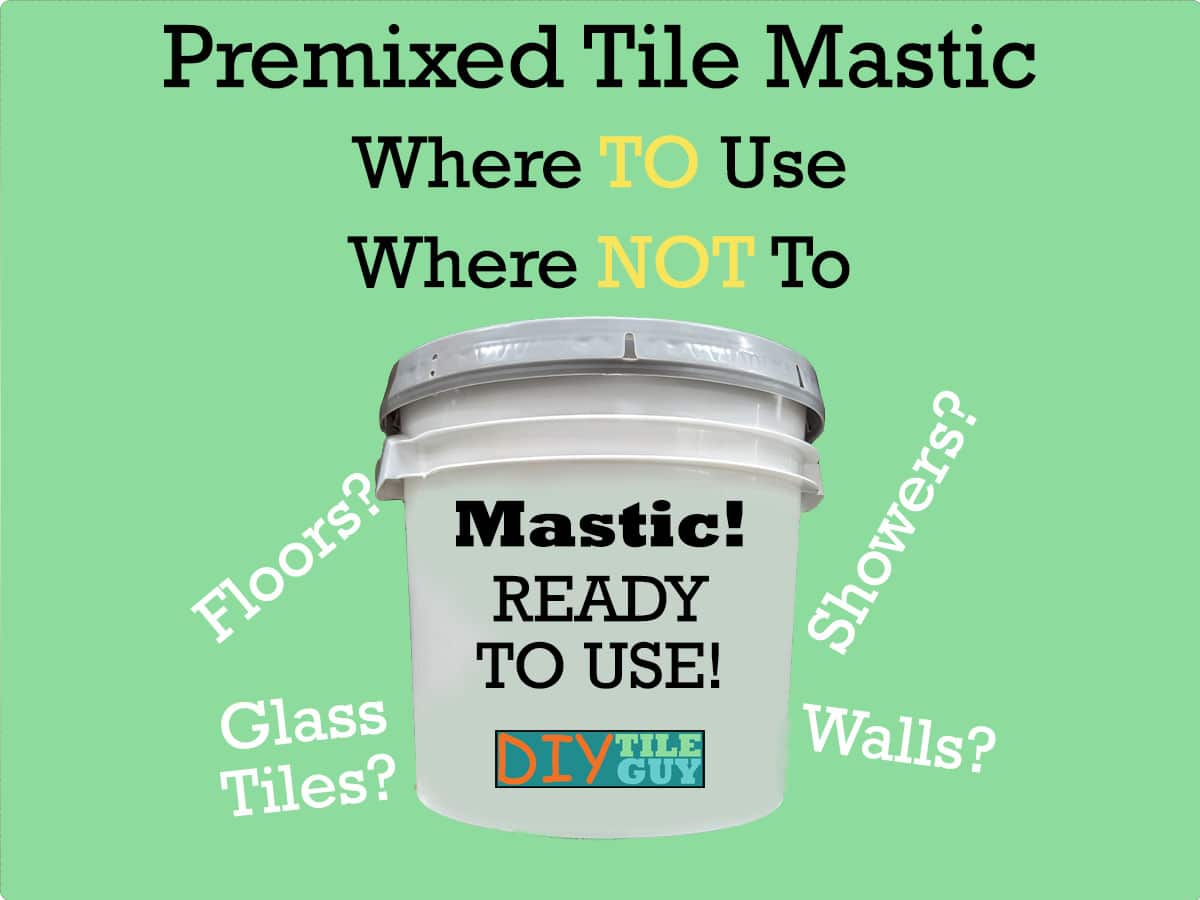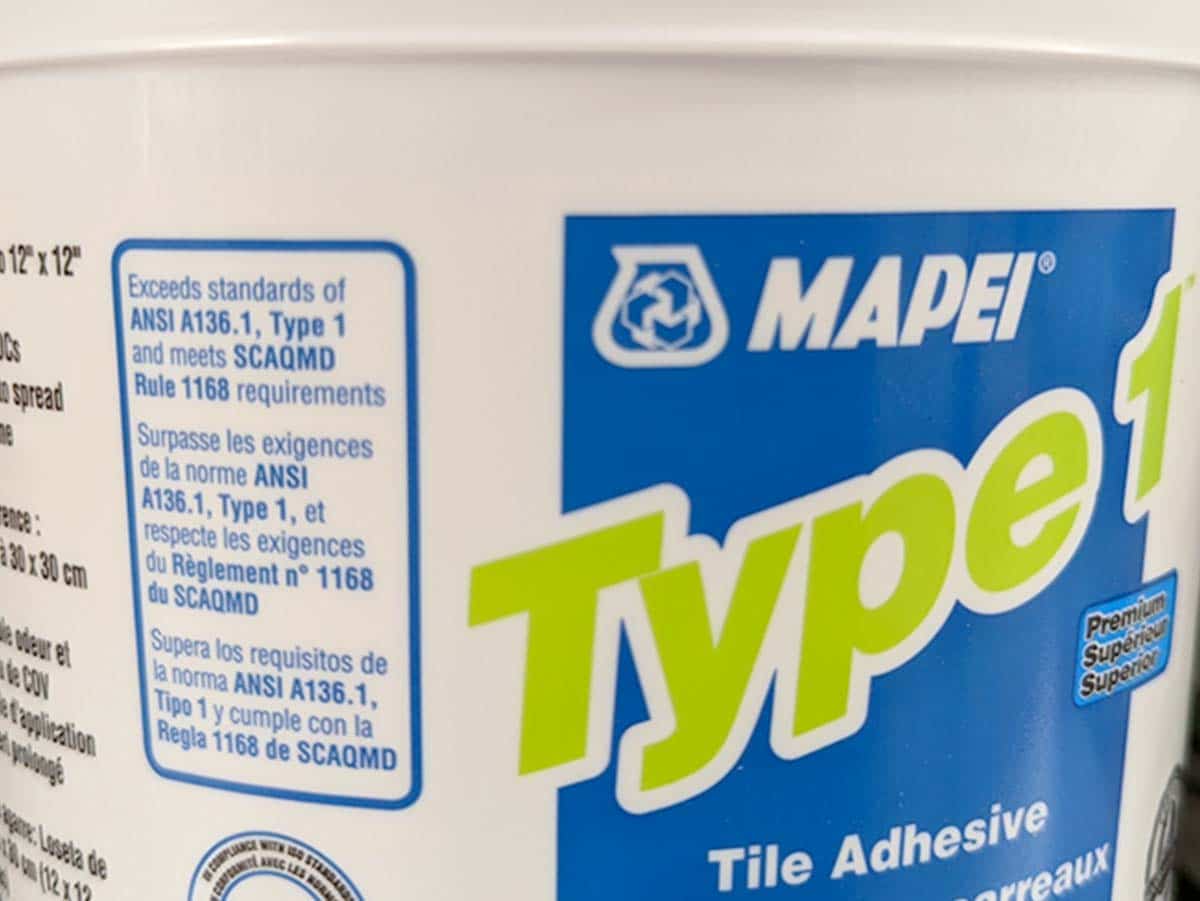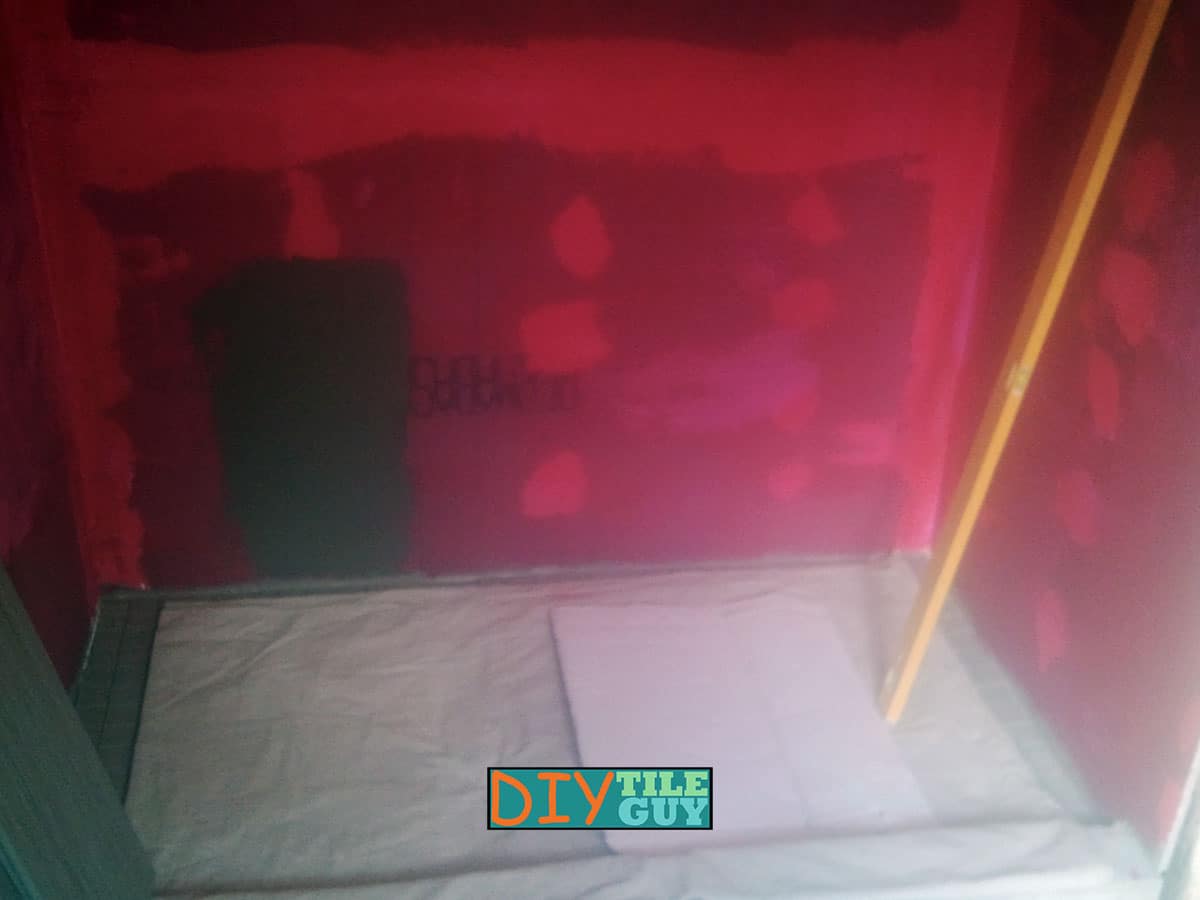You know how tempting it is to grab that bucket of premixed tile mastic off of the shelf for your tile project.
It’s premixed, already the proper consistency, and it’s really easy to use.
But you’ve heard the horror stories on the internet from people that used tile glue. The tear-outs. The mold. “Why isn’t this mastic drying?”
Don’t be sorry. Read this post first.

Estimated reading time: 9 minutes
Table of Contents (Click to Expand)
What is mastic?
First of all, the basics. Mastic is a glue for installing ceramic tiles. It’s already premixed in a bucket so you simply spread it on a surface and it allows you to stick ceramic tiles to a wall.
You put the lid on when it’s not in use and you can store the adhesive until you want to use it later.
These products meet or exceed the industry standard testing procedures set forth in ANSI 136.1 for Type I and Type II organic adhesives [11]
What’s the difference between Mastic vs Premixed Thinset Mortar?
Organic adhesives (aka tile mastic) have been tested to meet ANSI A136.1 and will fall into the category of either Type 1 or Type 2.
However, products labeled as premixed mortars don’t always meet the requirements of type 1 or 2. This means there’s no third-party testing and these premixed thinsets don’t necessarily meet ANSI standards.
Despite this, many manufacturers imply, or outright claim, their premixed thinsets out-perform their Type 1 and Type 2 adhesives. In other words, you have to take their word for it.
Bottom line:
There is some jockeying with technicalities and definitions going on here. However, one thing these products are not is cementitious mortars.
Whether it’s tile mastic or premixed thinset, they both come in a bucket which means they need air to dry.
What’s the difference between Type 1 and Type 2 mastic?
The main difference between type 1 and type 2 mastic is that type 1 is more water-resistant than type 2. [12]
Mastic vs Thinset Mortar
Whereas mastic comes premixed in a bucket, real cementitious thinset mortar comes in a bag and is mixed with water to the proper consistency.
Yes, choosing the proper thinset mortar can be confusing. But that’s because it’s made for a wide variety of applications. Most of the time you should be mixing your mortar vs buying it premixed.
Keep in mind that thinset mortar is different than the premixed mortar I talked about above.
Why people love mastic for tile installation
It’s not unusual for contractors and DIY’ers alike to want to grab the mastic bucket off of the shelf and use it for everything.
In fact, it’s pretty common for associates at the home improvement stores to recommend tile mastic no matter what it is that you are installing.
Glue for tiles is easy to use
For starters, mastic is incredibly simple to use compared to its mix-with-water counterpart, thinset. It grabs the tile really well but still allows for adjustment.
These premixed tile adhesives are the right consistency
Additionally, mastic comes premixed in a bucket and is ready to trowel. You’re achieving the perfect consistency without even trying.
On the other hand, it’s more difficult to mix thinset mortar properly and get the right consistency.
Plus, not everyone has heard of my Exact Batch Cheat Sheet where I give you the exact correct ratio of thinset and water to mix together so you can mix thinset perfectly, every time!
Premixed tile mortar cleans up easily
Then, when you’re done, you can put the lid back on and clean up your tools in water. What’s not to like?

So Why Not Use Premixed Tile Mastic for Everything?
So, I’m encouraging you not to get too attached to these premixed adhesives. In fact, they have a surprising number of limitations that people don’t always realize.
These premixed adhesives need air to dry
Think about it. They come in a bucket. Mastic doesn’t dry unless you open the lid and let the air in.
So, what happens when you spread the premixed mortar over the floor and then put a large format tile over it?
Essentially, you’re putting the “lid” back on the bucket. Therefore, the bigger the tile, the longer to dry.
How thick can mastic be applied?
This is another thing. The thicker it’s applied the longer it takes to dry. Ideally, you’ll want smaller tiles set in a thin layer of mastic to maximize the amount of air that can get into grout joints and dry things out so it hardens.
In my own research, it seems that 3/16th thick is where many manufacturer’s draw the line. Further, they note that the adhesive will take significantly longer to dry at maximum thicknesses.
What happens to mastic when it gets wet?
When mastic gets wet enough it can soften up and turn more liquid-y. Once this happens this ‘organic adhesive’ turns into food for mold. Now you have a big mess on your hands.
Premixed mortar not drying
Do a search for “tile mastic not drying” and you’ll come up with a lot of results that talk about people who tiled their floors and had to rip them all out because the premixed adhesives wouldn’t dry underneath.
Where not to use Tile mastic or Premixed Mortars
So, with all that being said, let’s get more specific on where not to use these premixed tile adhesives.
Tiling over Redgard
Using Mastic over Redgard or any waterproofing membrane is a big no-no.
Yes, type 1 mastic may be water-resistant and the back of the bucket may say that it’s OK for intermittent wet areas.
However, it also specifies that the product is not to be used over waterproofing membranes such as Redgard.
In fact, the datasheet for Redgard specifically states: [3]
Do not use pre-mixed adhesives over membrane.
Install tile or stone with a Custom® Building Products polymermodified mortar that meets ANSI A118.4 or A118.15 standards based on application requirements.
Redgard Technical Data Sheet~ 4/2021
Additionally, pretty much every manufacturer of premixed mortar and mastic warns against using them over waterproof membranes and shower floors. [4,5,6,7,8,9,10]

Mastic over Ditra
Schluter specifically prohibits using premixed tile adhesive over any of their uncoupling membranes like Ditra, Ditra-Heat, Ditra XL, and Ditra-Heat-Duo. [1]
Premixed Tile Mortar over Kerdi membrane
Using any kind of premixed mastic over Schluter’s Kerdi membrane isn’t recommended. [2]
Schluter wants you to use a quality unmodified mortar or one of the Schluter branded thinset mortars like All-Set.
Can you use mastic on large porcelain tiles?
Typically, it’s not OK to use premixed tile adhesives for 12×24 tiles and other large formats. Most large format tiles exceed the maximum size limitations that are listed in the premixed adhesive’s data sheets.
Mastic for glass tile
Most of the tile adhesive’s instructions forbid the use of their product to install glass tiles. Further, even if some allow it the glass tile manufacturer will, oftentimes, forbid its use. [4,5,6,8]
TLDR; don’t use premixed mastics for glass tiles of any size.
Natural Stone
Most mastic manufacturers recommend against using this product with natural stone. [4,5,8,9,10]
Fireplaces
Most of the tile mastics have temperature limits that a fireplace can exceed. Therefore, it’s probably not a good idea to use a mastic around a fireplace even if you are sticking tile to the drywall that surrounds it.
Floors
A lot of premixed mastics will allow their use over floors. However, I think this is a bad idea. If you do choose to use this to stick your floor tile down make sure:
- Don’t exceed the maximum thickness
- Don’t use it for large format tile
- Don’t install over the top of floors that will be heated
- Don’t install over membranes like uncoupling or waterproofing membranes
- Give it lots of time to dry. 48 hours plus, in my opinion.
Floors
Never, ever, install shower floors with premixed adhesives. That’s one of the worst environments you could possibly use mastic.
Where TO USE Premixed Mastic
As you might have surmised, the list of where not to use mastic is much longer than the list of where it’s a good idea to use it.
However, there are a couple of applications that mastic works really well for.
Over Drywall
Drywall and mastic are just made to go together. If you’re looking to use a tile glue to stick your tiles on with, drywall is the great place to stick’em.
Can I use tile mastic on cement board or Hardibacker?
I’m not crazy about installing over backer board with mastic. If you do want to do this, flip the smooth side out (on cement board) as the tile glue will grab the smooth side a little better. [13,14]
Ceramic wall tiles
Ceramic wall tiles are a great choice if one is going to be using a premixed adhesive. Small tiles and all the way up to 6×6, or so, are great tiles to install. This includes 3×6 subway tiles, 6×6 wall tiles, 4.25-inch tiles, etc.
Kitchen Backsplashes
Ceramic tiles on a kitchen backsplash over drywall is a great application to use a premixed tile adhesive with.
Conclusion
There are many, many applications where you don’t want to use mastic:
- Floors
- Showers
- Over waterproofing like Redgard
- Over membranes like Ditra
- Natural stone
- Big porcelain tiles
However, if you’re sticking subway tiles to a kitchen backsplash- have at it!
Frequently Asked Questions about tile mastic and premixed mortars
Yes, mastic will adhere to painted drywall. However, it’s not a bad idea to rough up the drywall first with sandpaper.
No. Mastic is a premixed glue that comes in a bucket and thinset is a cementitious powder that needs to be mixed with a liquid to achieve its proper consistency.
Although the bucket of Type 1 mastic may claim that it has water-resistant properties, you’ll rarely have the circumstances where it’s truly OK to use mastic in a shower.
Installing large tiles is outside of a mastic’s capabilities. As are installing over a waterproof membranes or foam backer boards.
Drywall is a perfectly acceptable substrate to tile over using a premixed organic adhesive like a mastic.
No. Mastic is an adhesive used to stick ceramic wall tiles to drywall. Grout goes in between the tiles and is part of the finished tile installation.
If the original tile installation was installed with a particular Thin-set mortar, then the repair should have been made with the same mortar or a rapid version of the same thin-set mortar. Mastic is not considered the best product for installing tile on floors.
https://ctasc.com/expert-answers/is-it-ok-to-use-a-mastic-for-a-repair-rather-than-thin-set-mortar-that-was-used-for-the-original-installation/
References
- https://www.schluter.com/schluter-us/en_US/faq/ditra-ditraxl-premixed-thin-set-mortar-tile
- https://www.schluter.com/schluter-us/en_US/faq/shower-system-kerdi-premixed-thin-set-mortar-tile
- https://www.custombuildingproducts.com/wp-content/uploads/2021/08/TDS-104-051721.pdf
- Custom Building Products Acrylpro technical datasheet [TDS-127]
- Custom Building Products OmniGrip technical datasheet [TDS-126]
- Custom Building Products SimpleSet technical datasheet [TDS-182]
- https://cdn.laticrete.com/~/media/product-documents/product-data-sheets/ds-286.ashx?sc_lang=en&vs=1&d=20200401T200147Z
- https://cdnmedia.mapei.com/docs/librariesprovider10/products-documents/1_3000236-type-1-en_bf6add773802469399dbc8e3cb6b2032.pdf?sfvrsn=498c40d2_0
- https://cdnmedia.mapei.com/docs/librariesprovider10/products-documents/1_3000304-premium-mortar-en_eba8aba0ca64461f8608d9554718fe1d.pdf?sfvrsn=790037e8_0
- https://www.tecspecialty.com/hbfuller-media/3060/pds_tec_122_doubleduty_r1120.pdf
- https://blog.ansi.org/2020/07/ansi-a108-a118-2020-installation-ceramic-tile/#gref
- American National Standards Specifications for Organic Adhesives for Installation of Ceramic Tiles A136.1 Section 3.0-3.2 [2022 page 128]
- https://www.usg.com/content/usgcom/en/resource-center/faqs/durock-installation-side.html
- https://www.jameshardiepros.com/getattachment/98adb0c7-1bd1-49e7-a9d4-a8275d29ae4a/hardiebacker-installation-guide-english-spanish-hb1710.pdf